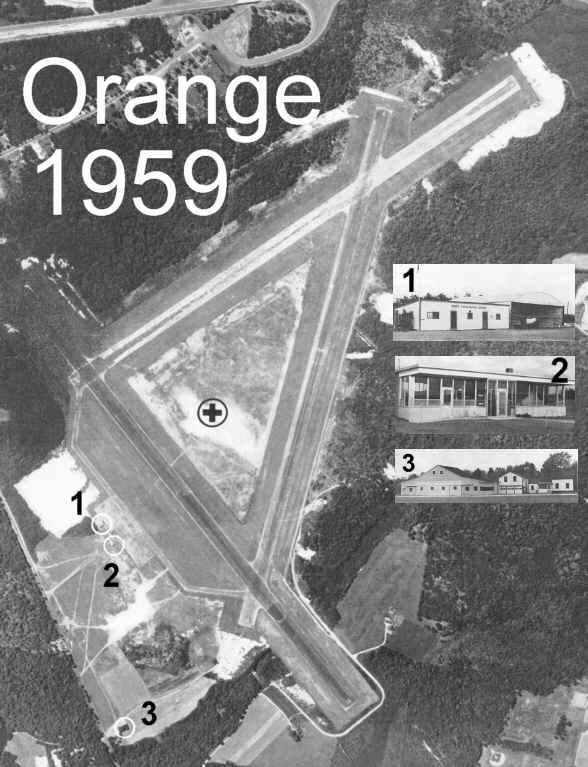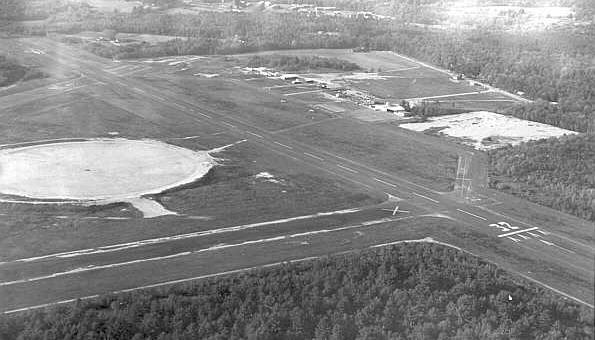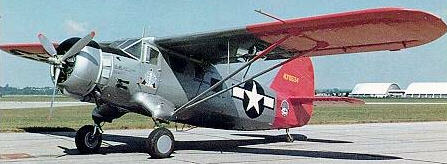
 |
| Airport/Facility
ID : ORE
Facility Key : 09187.*A Facility Name : ORANGE MUNI Facility Type : AIRPORT County : FRANKLIN City : ORANGE (01 miles SE) State : MA Lattitude/Longitude : 42.570116666667/-72.288605555556 (Estimated) Elevation : 555 ft. (Surveyed) Magnetic Variation : 15W Owner : TOWN OF ORANGE Owner address : 6 PROSPECT ST, ORANGE MA 01364 Owner telephone : 508-544-1106 Manager : LEONARD BEDAW Manager address : 80 AIRPORT STREET, ORANGE MA 01364 Manager telephone : 508-544-8189 Sectional : NEW YORK Control tower : Lights : DUSK-DAWN Segmented circle : N Beacon : CG Landing fee : N UNICOM : 122.800 The new and exciting sport of parachuting was growing by leaps and bounds, mostly leaps. In 1956 only about 200 jumps were made in America. By the end of the next year, 1957, that number had grown to 1,500 and in 1958 over 5,500 jumps were made! Parachutes incorporated would make a major contribution to the 10,000+ jumps made in 1959. 1959 was an exciting year for the sport. In August, the USA beat the Soviet team for the first time scoring 2nd place out of nine countries at the Adriatic Cup in Tivat, Yugoslavia. Loy Broydon also set his personal records by beating the Russians by taking 2nd place in the overall performance catagory. Previous to that we missed the first world meet in 1951, Fred Mason took 21st place in the 2nd World Championship (1954) in St. Yan, France and in 1956 at the 3rd World Championship held in Moscow, PI's founders Lew Sanborn and Jasques Istel lead the first complete US Team. Lew was the meet high scorer. Istel and Sanborn left their duties at Good Hill Farm DZ to attend the 1958 World Meet with 14 countries competing. Jasques Istel was the high scorer. 1958 Parachute Club of America dues went up to $15 reflecting the groth of the organization and services to the members. Lew and Jasques jumped in with both feet and in February 1959 Lew and Jacques signed a 20 year lease with the City of Orange, Mass. for the whole of Orange airport. Jacques and Lew brought in two more stock holders and employees, George Flynn and Batch Pond's son, Nate (D-69). They built a hanger, classrooms, training areas (Photo #1- click for photo or click on insert in big photo), rest rooms, outdoor packing tables and used the original airport admin building (Photo #2-Click for photo or click on insert in big photo) for airport business, communications with the aircraft, ticket and equipment sales and a general reception area. They also had the use of the original red pre-war hanger, fire station and other small buildings (Photo #3-Click for photo or click on insert in big photo) at the other end of the flight line by runway 13 for aircraft and parts parts storage, an indoor loft, a bunk house and bar with rental lockers and the general business offices of Parachutes Incorporated. The parachute area alone was 5400 square feet! Inside the triangle formed by the three 5000' runways was a 52-acre landing area with added sand for soft landing. Loud speakers were purchased to help guide students into the target and a funny looking trainer was used to bring in the landing area equipment at night for storage (See left side of the first employees photo). The Cessna 182 was joined by a Cessna 180, "84 Charlie", painted in the same company colors and the search for suitable 10-place Norseman began. They also negotiated for stand by aircraft for busy days or when the Cessna were in need of service. An old station weagon and a VW Van to bring students back from the DZ were purchased completing the PI hardware stable. Parachute wise, PI bought 50 parachutes, a mixture of USAF surplus C-9 28' mains and new 32' LoPo mains and matching 24' and 28' reserves. The harness and containers were all new custom built by Pioneer Parachute for PI. Helmets, coveralls, flotation gear and cushioned paraboots completed the gear for rent. Next
came a pricing structure:
The final step was employees. Istel, Pond, Sanborn and Flynn (in white below) were supplimented by 5 desert rats, packers and other types plus ??? who ran the office. .  With all their ducks in a row, Istel, Sanborn, Pond and Flynn opened the first purpose built commercial Sport Parachute Center in the USA at 9am on May 2, 1959! (Click for early photo) |
 |
 |
 |
 |
In
Early 1962 they added to the facility and built a huge Para-Bowl for the
1962 World Meet.
..
| The
following article previously appeared in the May 7, 1959 issue of the
Enterprise and Journal (Enterprise Vol 77, No. 45; Journal Vol. 89), a weekly newspaper, published every Thursday in Orange, Massachusetts Serving Orange and Vicinity since March 25, 1871; price Ten Cents.
The layout of the new center was a product of the new philosopy of the company. Though aimed at the civilian sport market, there were still many military style aspects to the physical and psychological make up of the center. For one thing, everything was very orderly compared to other drop zones of the day. Students were looked after efficiently and a dress/color code that indentified the function of the employees was adopted. All PI employees wore PI designed clothing and jumpsuits were color coded in white or dark and later white, yellow and pink. Rather than someone running around with a clip board, the manifest was big and easy to read. Every jumper and his friends or family could see where they stood on a load and how far they were from it. The manifest area also had a radio and could keep in touch with the aircraft and pilots usually contacted the manifest to tell them they were empty and coming down. .
The one very special thing about
the new center was a training method they developed called the TELSANTM
Method
(the
word TELSAN stood for "isTELSANborn", the combination of their names).
Up till that time and for many years afterwards, civilian and military
clubs took days or weeks to train first jumpers. They not only learned
the basics but also things like packing parachutes and most made their
first jump on a parachute they packed themselves. The TELSAN
Method took only three hours and trained the first timer only to make the
first jump. Each successive jump required new training which the
jumper paid $2 for. This saved the company (as well as the student)
much time and money since most first jump course students don't come back
for a second jump. "Been there, done that, bragged about it at the
Fraternity House till everyone is sick of hearing about it!" :-)
PI
also had the best equipment rental system. You could rent cushioned
boots, helmets and jumpsuits as well as your main and reserve. The
photo below shows the equipment rental ticket. More on this aspect
of the company in the Lakewood section.
|
 .
.|
The 182 was far from capable of handling the volume of jumping they hoped for and they decided they needed a single engine aircraft capable of handling 8-10 jumpers. Only two civilian AC types would fit the bill, the Fairchild Model 71 (which were few and far between by 1959-60) and the Canadian Noorduyn Norseman (US Army Air Forced UC-64A). Over 750 Norseman had been manufactured before and during the war and were surplused from the Canadian and US military with the introduction of the "Otter". PI found and bought 4 of them from Alaska and Canada. They modified the doors and steps for jumping and removed all the right side windows. It was a slow, noisy, fabric covered aircraft with a 600hp Pratt & Whitney R-1340 radial engine but it had a very good useful payload and was the only aircraft that could fit the bill in that day. With over 750 manufactured, it was also quite available at a reasonable price PI could afford. PI aquired one from Western Alaska Airlines (complete with floats) and a second from Wien Alaska Airlines. They experimented with several color schemes and standardized on two and eventually to one by 1970. More on the Norseman and other jump planes in the aircraft section of this site. |


| (The top photo
shows the Norseman in the UC-64a configuration. The photo below it
shows the open door and seating configuration in N1207, (that's me by the
way fastening the helmet) The door was probably the largest jump
door in the USA at the time. The Russians had us beat though with
the door on the huge bi-plane transport, the AN-2 COLT which was and still
is a very popular jump plane in the "East". A short history of it
is in the section on the 6th World Parachute Meet.
. |
| PI was the successful bidder for
the site of the 1962 World Meet where the Americans walked off with
the majority of medals. The over-all world champ was Oklahoma born
Sgt. Jim Arender, an Army jumper who was occasionally seen at Lakewood
and Orange. They also hosted the 1962 Governor's Cup Meet soon after.
After the meet, jumpers returning home spread the word about this "super center" and people came from all over the world to jump there including the French Woman's Champion.
I must note that this site is being created in Melbourne, Australia. PI had one Australian jumpmaster/instructor named Don West. Don looked more like the typical blonde Australian superstud lifeguard than a skydiver. Don represented Australia at the World Meet in 1962 along with Bill Molloy and Kathy Ann Henderson. It was the first team to represent Australia at a world meet. Don stayed on in the USA to further his parachuting career at Orange and Lakewood. He came back to Australia to compete in the 1964 Australian Nationals. Before that though, Don and a team from South Australia were out to beat the World Baton Passing Record. Don and Joe Larkin went low to try and make the last and record setting pass. Don let the other jumper open so they wouldn't entangle and his reserve didn't fully open in time. He is buried in Adelaide next to his girl friend who had been killed in an auto accident. Kip and Lee Zervos (see people page) both met his sister when she came to the States after his death. Don was Kips' FJC instructor. Claude Gillard (the current Australia Parachute Federation, president) kept Don's Pioneer LoPo (which he bought at Orange) which was black and white candy stripes with a red lobster tail and his memory was further kept alive when Claude had all of the Labatouche Centres "Gilstars" (also called the Argosy) made in the same color pattern. Claude, like many foreign jumpers came to the Lakewood and Orange DZ's and saw them as Super Centers which in fact they were.
In later years Orange SPC had it's problems with the city over the noise of the Norseman and the city failed in an attempt to forbid the use of them at Orange Airport because the airport was partially federally funded. Orange also had it's fair share
of aircraft mishaps but considering that takeoffs and landings are the
most dangerous part of flight operations, and that an average jump flight
lasted 45 minutes or so, that's a lot of takeoffs and landings per 100
flight hours vs. cross country flying, so that probably
In late 1962 Norseman N1207 on it's back because of a break lock. It was repaired and moved to Lakewood where it remained till it was written off. Later in the 60's while taxiing
in after landing, a Norseman chewed right
Two of the three Norseman that came to grief did so at Orange. 990K had a landing accident in 1974 and was sold to two Canadians who moved it "home" for rebuilding. 795 ("Red Lead") crashed and burned after loosing power at 400' taking off from runway 19 in July 1979. No one was killed or even seriously injured. Newspaper clippings can be found on the Norseman page. With dwindling Norseman numbers and more DZ's to supply, PI added a Cessna 180, N2984C, with a Snohomish door to Orange in 1966, another Cessan to Lakewood, a leased Twin-Beech in the 60's and an SNB-5 Twin Beechcraft in 1978 and later a Cessna 195 and Cessna 205. The Norseman remained the mainstay student aircraft till they closed their doors and the Beech was used for large stars (large for the day of course) and experienced jumpers. PI, along with "POP" Poppenhager's DZ in California, pioneered the use of the DC-3/C-47 for sport jumping. The first time was in 1961 and again in 1963 using a white executive DC-3. In 19?? they aquired 3 DC-3's from Texas and flew them at Orange, Elsinor and occassionally Lakewood. These aircraft lifted 30 jumpers per load. Orange Sport Parachute Center was also the home of CPI or Connecuit Parachutists Incorporated, form many years till they relocated to Ellicot CT. Orange was open from 9am to sundown everyday of the week but Tuesday and survived the longest of the 5 DZ's. The layout stayed the same for the entire time it was open and it is now operated by a club called "Jump Town" using newer facilities. Members of the Pond family still jump there as do some of the PI jumpers and former employees, some of whom are helping with this project, Lew Sanborn even wrote once with some information. Lew was seriously injured when his Luscomb crashed and burned in 19??. He went thru some pretty radical facial restructuring and to his credit is still jumping in his 60's. Recently he was the first man on earth to complete 50 years of skydiving. He left the company in 1967 and currently lives in Imperial, Mo.. He is the best know of the PI pioneers. The Parachute school itself did not survive after PI shut down. In the mid eighties, after PI closed, a company called City Engines, who rebuilt aircraft engines, moved to Orange. The apron was extended approx. 200 yards to the east with a Federal grant, and a new building was erected on the old site. Only the hanger and admin building survives today. City Engines moved out of Orange in the early 90's and Jump Town know occupies part of that building. PI's central office was not at the airport itself but in an office in downtown Orange on Main Street. The normal corporate functions were handled there as well as warehousing for the Pioneer distributorship they owned and the main loft was also located there (The DZ loft was in a quanset hut next to the training area). A white PI van (shown in the photo of the aircraft page) made regular trips to Pioneer in Connecticut and the DZ to pick up and distribute new gear. In it's long history of almost a million jumps, Orange SPC had 4 fatalities during the period of operation from 1959-1982, the first on May 27, 1970. By that time the DZ had over 150,000 jumps made there. PI also operated a water jumping site at Lake Mattawa about 3 miles West of the airport. |
[ Home
] [ 1962 World Meet ] [ Good
Hill Farm ] [ Orange ] [ Hemet
] [ The INN ]
[
Lakewood
] [
Crawfordsville ] [ Elsinore
] [ People Page ] [ Aircraft
Page ]
Project PI is an online collaborative effort to document the first commercial parachute company, Parachutes Incorporated, its 6 DZ's, it's 15+ aircraft and as many of the personalities that worked or jumped there that we can find. Anyone may contribute with stories, information and photographs and are encouraged to do so. Click on the logo above to send e-mail to Thom Lyons, Project coordinator in Melbourne, Australia